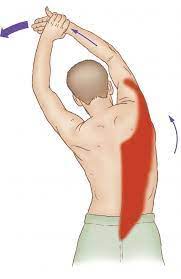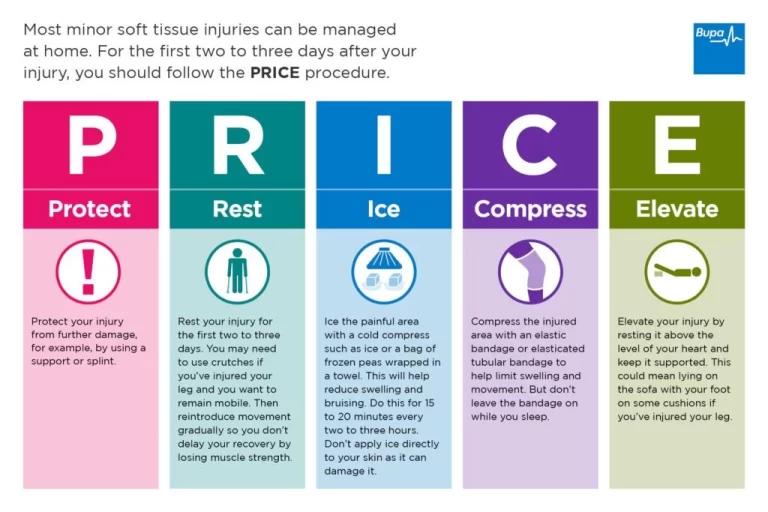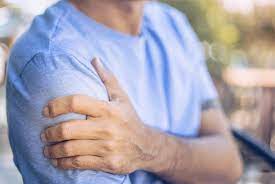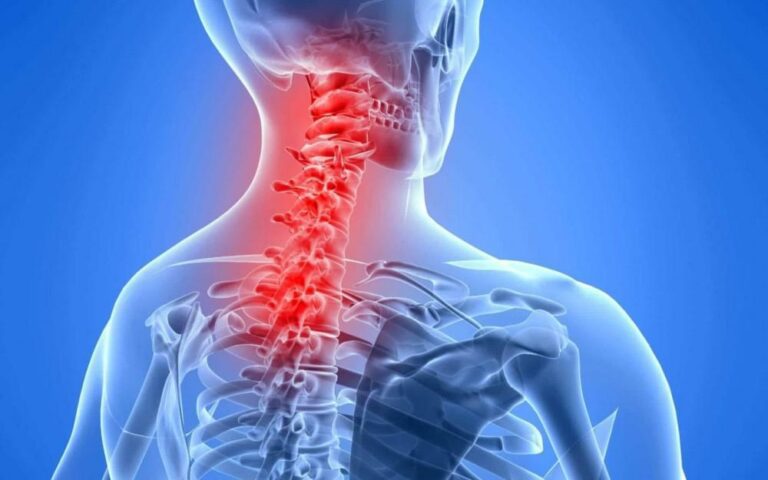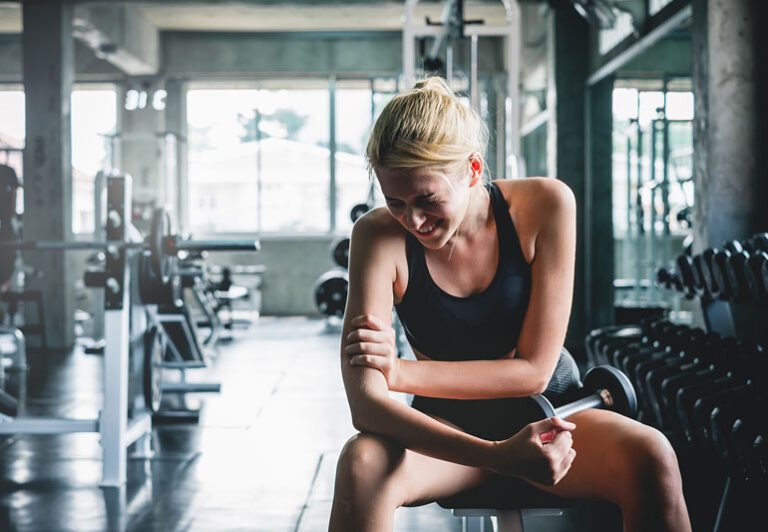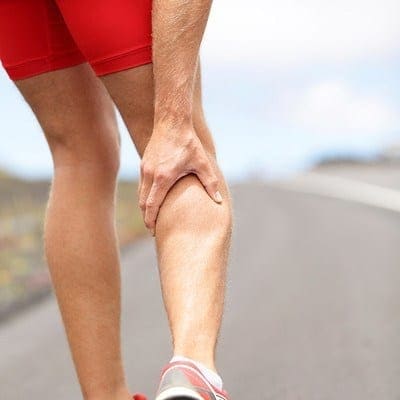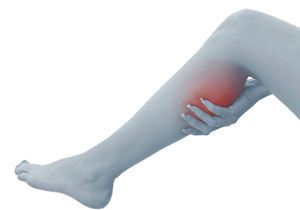Latissimus dorsi muscle pain: Cause, Symptoms, Treatment, Exercise
When you feel pain in the low back, mid-to-upper back, the base of the scapula & or the back of the shoulder joint, it is indicated to
latissimus dorsi muscle pain. this pain is produced for many reasons like a tear in the latissimus dorsi muscle, or overwork of the muscle. You feel pain, swellings, and spasms in the area of pain. this pain is relieved by the RICE principle, pain medication & physiotherapy treatment.
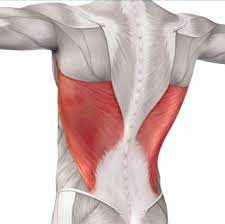
Table of Contents
What is the Anatomy of the latissimus dorsi muscle?
- This latissimus dorsi is one of the largest muscles in the back.
- It is sometimes referred to as lats & this muscle is known for its large & flat “V” shape.
- The function of this muscle is to span the width of the back & helps to control the movement of the shoulders joint.
What are the causes of the latissimus dorsi pain?
- This latissimus dorsi muscle is used during exercises in the exercises involve to pulling & throwing.
- This muscle pain is usually caused by overuse of the muscle.
- During exercise is used to the poor technique of the body.
- If you do not warm up before the exercise.
- Some Activities which is produced to latissimus dorsi pain include:
- Shoveling snow
- Tennis
- Chin-ups and pull-ups
- Gymnastics
- Swimming
- Reaching forward or overhead repeatedly
- Baseball
- Chopping wood
- Rowing
- You also feel pain in the latissimus dorsi muscle when you are used to poor posture in daily life which is lead to slouching posture.
- In rare cases, this latissimus dorsi muscle tear.
- It usually occurs in professional athletes, like baseball pitchers, golfers, water skiers, rock climbers, volleyball players, track athletes & gymnasts.
- Some everyday activities which are produced latissimus dorsi muscle pain include:
- When you pushing against the armrests of a chair to stand.
- When you expand the chest for breathing.
What are the symptoms of the latissimus dorsi muscle injury?
- When the injury occurs in the latissimus dorsi muscle, a person is feel pain in several places of the body, including:
- The lower, middle, & upper back.
- The back of the shoulder joint.
- The base of the scapula which is commonly known as the shoulder blade.
- Which is radiated to the inside of the arms & extending down to the fingers.
- This pain is become worsens when the person extends the hands to the front & raises the hands above the head & or throws an object.
- Other symptoms include :
- You are feeling difficulty in breathing
- The feeling of tingling in the lower arms
- Tendinitis in the middle & lower back
- You also feel tender & trigger points in the area of pain.
- You feel swellings, spasms & tightness in the muscle pain area.
When do you need to consult a doctor for this muscle pain?
- If you can not identify the source of back pain with some points like as;
- Trouble breathing
- Abdominal pain
- Fever
- When the pain is severe & not relive after primary treatment.
What is the treatment of latissimus dorsi pain?
RICE principle:
When you feel pain in the muscle in the starting phase doctor advice to you RICE principle to release muscle pain & swelling.
- R – rest = Sometimes do the resting of back & shoulder joint from the use and do not any physical activities which are produced to pain.
- I – ice = You can apply ice in the painful area for 20 minutes reduce to muscle pain & swellings, you can also be used an ice pack & frozen peas in the area of pain. always apply to the ice with the help of a towel prevent to ice burn.
- C – compression = You can also use to compression bandage on the area of pain release to swelling & spam.
- E – elevating = You must be elevated to the area of pain by sitting upright & placing the pillows behind the upper back & shoulder joint.
Pain medication :
- You can also take to non-steroidal anti-inflammatory drugs = NSAIDs like aspirin & ibuprofen (Advil, Motrin) which help to release muscle pain.
- When you have felt severe pain, your doctor prescribes something stronger drug.
- You can also apply volini gel & spray on the area of pain release to muscle pain & swellings.
What is Physiotherapy treatment for latissimus dorsi pain?
Physiotherapy treatment is help you release pain, swelling, spams & tightness of the muscle pain.
The physiotherapy treatment includes massage, electrotherapy, stretching, exercise, strengthening exercise & yoga.
Massage:
- When the muscle pain presents at tender points therapist is advised to massage the area of muscle pain.
- This massage is applied with the help of oil & powder for 5 minutes to the area of muscle pain.
- This massage is applied in a circular motion.
- This massage is also applied with the help of a messenger.
Electrotherapy treatment
Electrotherapy treatment is helpful to you for reliving the swellings, spams & pain.
The electrotherapy treatment includes too many machines.
- When the trigger & tender points are present apply to US = ultrasound therapy for release of muscle pain.
- This treatment is applied with the help of gel & applies for 5 to 10 minutes on the area of pain.
- This therapy helps you release pain & swelling.
- Reduce to pain therapist is applied to SWD = short wave diathermy, IFT = Interferential Therapy, TENS = Transcutaneous Electrical Nerve Stimulation on the area of pain.
- SWD = Short wave diathermy is hot therapy for release to spams on the area of pain.
- IFT = Interferential Therapy & TENS = Transcutaneous Electrical Nerve Stimulation is applied with the help of gel & electrodes on the area of pain.
- This therapy is applied for 10 minutes to the area of pain.
Stretching:
Stretching helps you relieve the pain & tightness of the muscle:
- Best Active Lat Stretches
- Active floor stretch
- Exercise ball stretch
Best Active Lat Stretches:
- The back & shoulder joints must stay against the wall
- Don’t arch the back
- The patient is must keep the elbow joint touching the entire time
- Drive the elbow joint in a forward & overhead motion
- To increase the stretch, try & separate the hands – while keeping the elbow joint together.
- This stretching is applied 3 times in 1 session & 3 sessions per day.
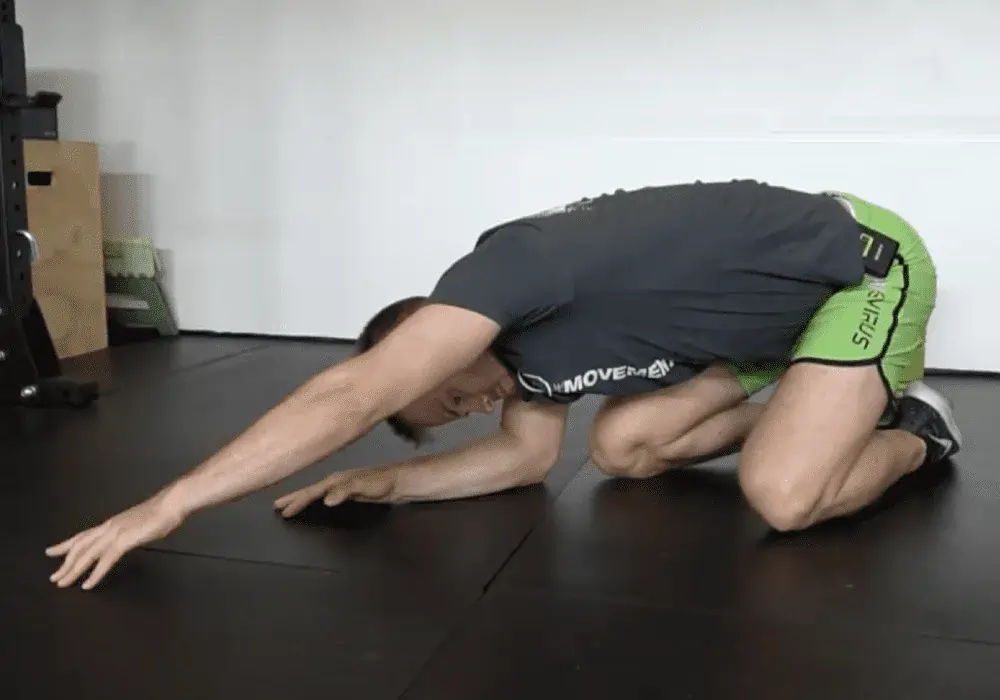
Active floor stretch:
- From a kneeling position, sink the hip joint back & place the right forearm along the floor.
- Then Lean the weight onto the right arm & stretch out the left arm, reaching out through the fingertips.
- The patient feels a stretch along the side of the torso.
- Hold this position for 30 seconds.
- Then Return to the starting position.
- Repeat this stretching 3 times & Repeat this exercise on the opposite side.
Exercise ball stretch:
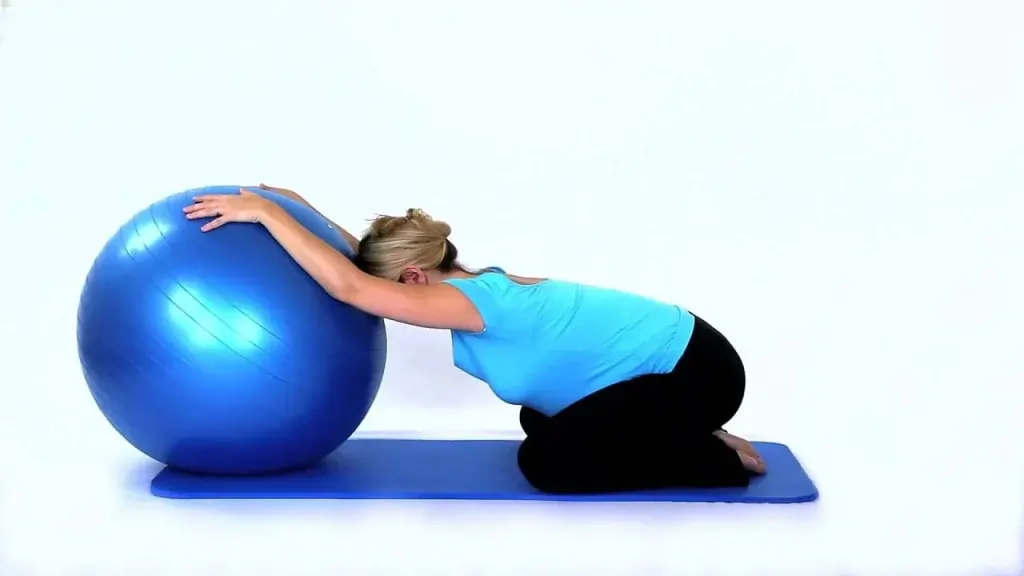
- This exercise starts on all four limbs in a tabletop position, in front of an exercise ball.
- Place the right hand on the ball with the thumb facing the ceiling.
- Press into the grounded arm for stability & support.
- Engage the core muscles as they extend the arm straight out, rolling the ball forward.
- Sink deeper into the stretch as they hold this position for 20–30 seconds.
- Then Repeat this stretching on the opposite side.
- Do each side of this stretching 2–3 times.
Exercise :
Exercise helps you release muscle pain & weakness.
- One Arm Row on One Leg
- Lat Pulls With Bands
- Foam rolling exercise
- Wall press
One Arm Row on One Leg:
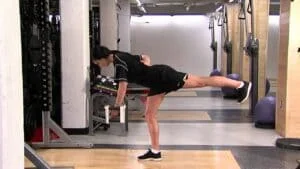
- For starting position shift the weight to the right leg & tip from the hip joint.
- Taking the torso parallel to the floor as they lift the left leg straight up.
- The body is lie in a straight line from head to heel.
- Hold a wall for balance
- From this position, pull the elbow joint up into a row & slowly lower down.
- When you feel shaky, take the leg down & rest lightly on the toes must keep most of the weight on the front leg.
- Repeat this exercise for 12-16 reps on each side.
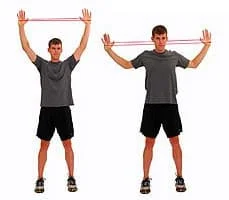
Lat Pulls With Bands:
- The latissimus dorsi muscle pulls with the bands & also used to lat pull machine at the gym.
- When you want to make this exercise more challenging, you can also use a door holder for the band & secure the band in a doorway above you.
- Alternative, hold the band overhead & squeeze the back to pull the elbow joint down towards the rib cage.
- Exercise harder, hold the band with the hands closer together.
- Repeat this exercise for 12-16 reps.
Foam rolling exercise:
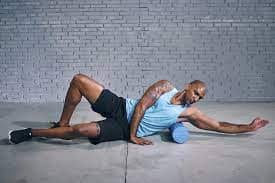
- The patient is Lying on the right side with the foam roller under the lat & maintaining a neutral spine.
- Must be Keep the right leg straight & bend the left knee joint however is comfortable.
- Rollback & forth from the lower back up to the underarm & try to move as slowly as possible.
- Then Roll from side to side.
- Continue this rolling for 1 minute.
- Repeat this exercise on the opposite side.
- Do the exercise 10 times in 1 session & 3 sessions per day
Wall press:
- The patient is Standing position about the 2 feet from a wall & facing toward it.
- Hinge at the hips to bend forward.
- Place the palms of the hands-on the wall at about hip height.
- Hold this exercise position for up to 1 minute.
- Do the exercise 10 times in 1 session & 3 sessions per day
Strengthening exercise:
This strengthening exercise helps you strengthen the muscle.
- Barbell Rows
- Dumbbell Pullovers
Barbell Rows:
- In the starting position, hold the barbell with the palms facing the body & tip from the hip joint till the torso is at about a 45-degree angle.
- You must lower the torso too far because it occurs to strain the back, mostly when the weight is heavy.
- Must be Keep the knees joint bent to protect the back.
- Take the bar straight out & squeeze the back to pull the barbell in towards the belly button.
- Then Repeat this exercise for 12-16 reps.
Dumbbell Pullovers:
- This exercise starts with a bridge position & holding a weight straight up overhead.
- Must be Keep the arms straight, elbow joint slightly bent.
- Then lower the weight to about the head-level or as far as a patient feel comfortable.
- Squeeze the back & slowly pull the weight back to start.
- Then Repeat this exercise for 12-16 reps.
Yoga
- Upward Salute
- Eagle Pose (Garudasana)
- Cat-Cow
- Downward-Facing Dog
- Upward-Facing Dog
- Child’s Pose
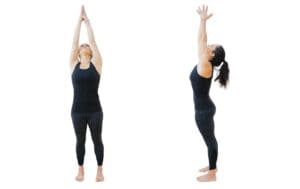
Upward Salute:
- This exercise starts within Mountain Pose (Tadasana) with the heels slightly apart & weight balanced evenly on both feet.
- Then Lift both arms toward the ceiling.
- Engage the core & tuck in the tailbone slightly, keeping the spine in alignment.
- When you feel comfortable then bend backward slightly.
Eagle Pose (Garudasana):
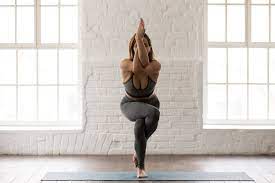
- For this pose, the patient is in a standing or sitting position.
- Rhen Stretch both arms straight forward & parallel to the floor.
- Cross the arms in front of the upper body so that the right arm is above the left arm.
- Bend the elbow joint.
- Tuck the right elbow into the crook of the left elbow & raise both forearms so that perpendicular to the floor.
- Press the palms together & breathe deeply.
- Then focusing on releasing tension in the back & shoulder joint.
- Then Reverse the arms & repeat this yoga pose 3 times.
Cat-Cow:
- This exercise starts on the hands & knees joint with a neutral spine.
- Inhale & move into Cow Pose by lifting the seat bones, pressing the chest forward & allowing the belly to sink toward the floor.
- When you exhale, move into Cat Pose by rounding the spine outward & tucking in the tailbone.
- Then Allow the head to release toward the floor in a relaxed position.
- Press firmly into the arms throughout both movements & pay attention to how the shoulder joint blades change position.
- Repeat this yoga pose 3 times.
Downward-Facing Dog:

- This exercise starts on all fours with the wrists under the shoulder & knee joint under the hip joint.
- Tuck the toes under & lift the hip joint off the floor.
- Straighten the legs & move the heels toward the floor.
- When the hamstring muscles are tight, it is OK to keep the knee joint slightly bent.
- The patient is also walking on the hands forward when you need more length.
- Then Press firmly through the palms & focus on broadening across the collarbones & shoulders.
- Allow the chin to tuck into the chest.
- Repeat this yoga pose 3 times.
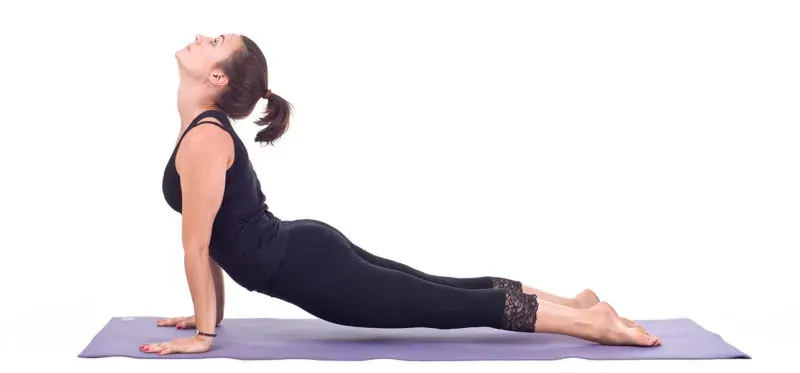
Upward-Facing Dog:
- The patient is lying on their stomach on the floor.
- Stretch the legs out the behind & rest the tops of the feet on the floor.
- Bend the elbows joint & place the palms on the floor beside the waist.
- Inhale & straighten the arms while lifting the upper body & legs are a few inches off the floor.
- Draw the shoulder joint back & down, away from the ears.
- Repeat this yoga pose 3 times.
Child’s Pose:
- From Downward Dog, take a deep breath & exhale.
- Release the knee joint onto the floor while pulling the hips back to the heels.
- Rest the forehead on the floor.
- You can also relax in this pose with the knee joint slightly wider than the hip joint.
- To deepen the stretch, walk the fingers as far forward as possible.
- Walk the fingers to each side before bringing them back to the center & resting in this position.
What are Prevention points for latissimus dorsi muscle pain?
- Always Maintain good posture & avoid slouching.
- Drink plenty of water throughout the day, mostly before & after exercise.
- You can also try occasional massage to loosen any tightness in the back & shoulder joint.
- Make sure you properly stretch & warm up before exercising & playing sports.
- Apply to the heating pad before working out.
- Always Do the cool-down after working out.
- Getting to occasional massages.

